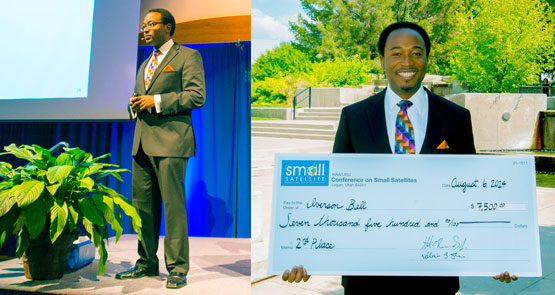Iverson Bell’s small satellite wins big
Iverson developed an experimental facility to simulate key characteristics of the space environment.

 Enlarge
Enlarge
Iverson Bell presenting at Small Sat, and holding his prize money, a check for $7,500.
Iverson Bell, a doctoral student in electrical engineering, took second place and a $7,500 prize in the 2014 Frank J. Redd Student Competition at the 28th Annual AIAA/USU Conference on Small Satellites (Small Sat Conference). The Small Sat Conference is the premier conference for research in highly integrated, very small satellites.
For the conference and competition, Iverson examined the capabilities of electrodynamic tether technology and developed an experimental facility to simulate key characteristics of the space environment.
In the first stage of the competition, students around the world submitted papers. Six students were selected to present their papers at the conference, and of those six, three were from Michigan! In addition to Iverson, the other two Michigan finalists and award winners were John Hwang, a graduate student in Aerospace Engineering, and Jeremy Castaing, a graduate student in Industrial and Operations Engineering. Hwang took third place and $5,000; Castaing received an Honorable Mention and $2,500.

 Enlarge
Enlarge
As a member of Prof. Brian Gilchrist’s research group, Mr. Bell is investigating the potential of electrodynamic tether propulsion technology to enhance the capabilities of an emerging class of “smartphone-sized” spacecraft known as picosatellites and femtosatellites.
Describing his research, Iverson stated, “The electrodynamic tethers I am studying are long, thin, conducting, semi-rigid wires, ranging from 1-30 meters in length. When they conduct current, the tethers interact with the planetary magnetic field to produce thrust without the need for traditional consumable “fuel” or propellant. All they need is electrical power, which can be generated using solar panels.”
“My research focus is to show that electrodynamic tether technology is capable of providing propulsion for very small spacecraft and may be able to provide attitude stability and function as an enhanced antenna aperture or serve as part of a ionospheric plasma probe. To demonstrate the system concept in the space environment, I am working with a team of students to develop a space mission known as the Miniature Tether Electrodynamics Experiment, or MiTEE.”
Mr. Bell expects to graduate in 2015. He received his undergraduate degree from Howard University, and is the recipient of an NSF Graduate Research Fellowship for his research in electrodynamic, propellantless propulsion for space applications (read more).
 MENU
MENU 
